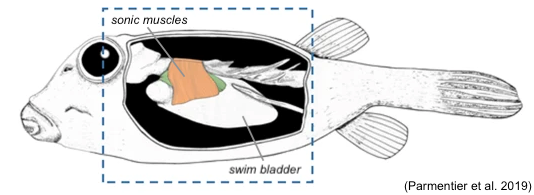- Share
- Share on Facebook
- Share on X
- Share on LinkedIn
Recruitment

The Context
Aquatic organisms produce sounds across a wide frequency range, relying on different mechanisms to generate them. Some invertebrates and bony fish emit high frequencies sounds greater than 3 kHz through stridulation, i.e. friction between two skeletal elements, and snapping, i.e. claw that rapidly closes, generating a cavitation bubble that implodes. Marine mammals can produce midrange sounds (500–3 kHz) by vibrating tissues-like vocal folds, using airflow they refresh. Finally, low frequencies (20–500 Hz) are performed with the help of a gas-filled pouch organ found in most teleost fish, the swim bladder (Parmentier 2006).
The primary function of the swim bladder is to ensure the buoyancy of the fish, sparing it the effort of maintaining its equilibrium in the water and swimming horizontally. It is assumed it has a hearing function in all species because of its proximity with the inner ear and may, in others, also act as a sound-producing organ. Most of the sound-producing mechanisms described in the literature involving the swim bladder rely on the contraction of very fast muscles, known as sonic muscles. They compress the gas-filled organ, either directly or with the help of intermediary structures (skeleton, tendons, etc.), at a specific rate.
Objectives
This internship is part of a larger research project whose initial stages focused on assessing the mechanical properties and vibratory capacities of the swim bladder. Based on these findings, a model of the mechanism was developed to predict and explain fish sound production. The final step of this project is to construct biomimetic prototypes, to demonstrate the sound production mechanism.
Outcomes
Since all fish use their swim bladder for hearing and some also for sound production, this organ can be considered a biological hydrophone and loudspeaker. Inspired by the structure and functioning of the swim bladder, this research project aims to develop new tools capable of transmitting and receiving low-frequency sounds underwater.
Methodology
The internship will involve the following steps:
- Understand the literature on the sound production in fishes,
- Make a review of the different anatomic principles of sonic muscles, and predict the forces exerted on the swimming bladder by the sonic muscles,
- Test different materials that reproduce the elastic properties of the membrane swim bladder,
- Build a prototype to produce sound: artificial swim bladder made in moulded elastomers,
- Measure the acoustic response of the biomimetic prototypes and compare with fish sounds.
Environnement
Laboratoire Interdisciplinaire de Physique is located on the beautiful Grenoble campus, France.
Supervision
The student will work in a team with Romane Frey and Philippe Marmottant.
Bibliography
Ladich and Fine 2006 - Sound-Generating Mechanisms in Fishes: A Unique Diversity in Vertebrates
Parmentier and Diogo 2006 - Evolutionary trends of swimbladder sound mechanisms in some teleost fishes
Example of a biomimetic sound-producing device (inspired by bird syrinx): Mukherjee et al. 2017 - Controllable biomimetic birdsong
Contact
Philippe MARMOTTANT
MOVE team
philippe.marmottant univ-grenoble-alpes.fr (philippe[dot]marmottant[at]univ-grenoble-alpes[dot]fr)
univ-grenoble-alpes.fr (philippe[dot]marmottant[at]univ-grenoble-alpes[dot]fr)
Web page
Romane FREY
MOVE team
romane.frey univ-grenoble-alpes.fr (romane[dot]frey[at]univ-grenoble-alpes[dot]fr)
univ-grenoble-alpes.fr (romane[dot]frey[at]univ-grenoble-alpes[dot]fr)
- Share
- Share on Facebook
- Share on X
- Share on LinkedIn